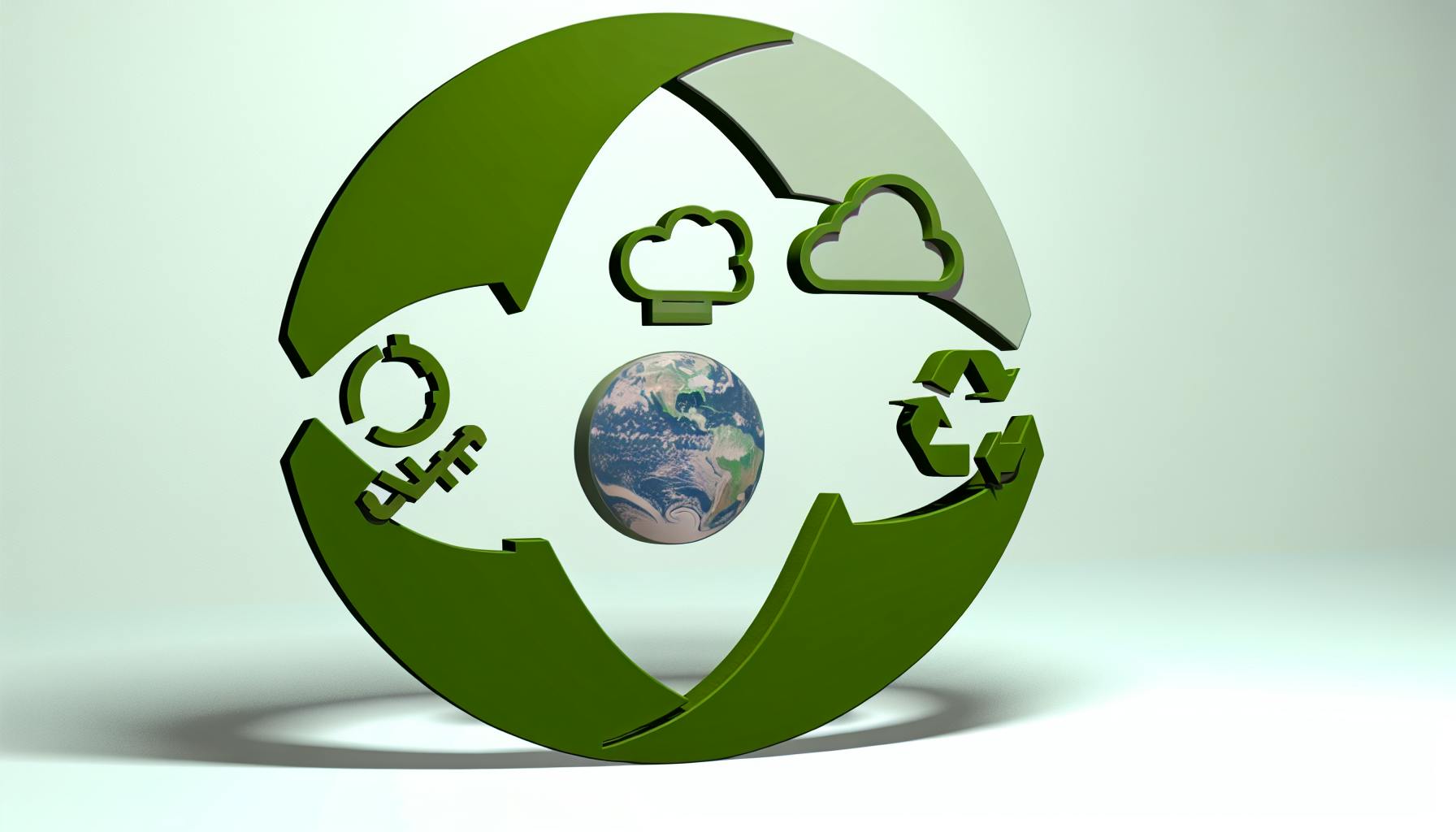Understanding carbon accounting can be confusing for SMEs. With so many scopes and emissions sources, it's tough to know where to start.
But having a solid grasp of the fundamentals - the key differences between Scope 1, 2, and 3 - opens the door to strategic emissions management.
In this post, we'll decode the jargon, walk through emissions categories with real-world examples for SMEs, and spotlight smart ways small businesses can prioritise reductions across scopes.
Introduction to Carbon Accounting for SMEs
Carbon accounting can seem daunting for small and medium-sized enterprises (SMEs). However, understanding and reporting your carbon footprint is becoming increasingly important. Key stakeholders like investors, customers, and regulators are demanding climate action and transparency from all businesses, regardless of size.
The Greenhouse Gas (GHG) Protocol provides the globally recognised standard for categorising emissions into three scopes:
- Scope 1 covers direct emissions from sources owned or controlled by the company. This includes emissions from fuel combustion, company vehicles, and industrial processes.
- Scope 2 accounts for indirect emissions from the purchase of energy. For most SMEs this primarily consists of purchased electricity.
- Scope 3 includes all other indirect emissions across the company's value chain. This wide-ranging scope encompasses emissions from business travel, waste disposal, procurement, transportation logistics, and more. For many companies, Scope 3 emissions make up the largest portion of their carbon footprint.
While Scope 1 and 2 emissions tend to be easier to measure, Scope 3 poses a far greater challenge. However, all three scopes provide crucial insights that enable SMEs to reduce emissions, comply with regulations, satisfy stakeholders, minimise risks, and capitalise on emerging opportunities.
This article explores practical strategies for SMEs to accurately measure and report emissions across all three scopes.
The Fundamentals of Scope 1, 2, and 3 Emissions
Categorising emissions enables focused measurement, management, and reduction efforts. The GHG Protocol delineates three scopes based on the level of control a company has over its emissions sources.
Scope 1: Direct Emissions
Scope 1 emissions come from sources directly controlled by the company. This includes on-site fuel combustion for heating/cooling systems and industrial processes, fleet vehicles like delivery trucks, fugitive refrigerant leaks from AC units, and more. For example, an eCommerce company would account for tailpipe emissions from its delivery vans in Scope 1.
Scope 2: Indirect Emissions from Purchased Energy
Most SMEs have relatively predictable Scope 2 emissions primarily consisting of purchased electricity. To calculate Scope 2, companies multiply their energy consumption by the emissions factor of their regional energy grid. For example, a software firm would account for emissions associated with the electricity used to power its offices and data centers in Scope 2.
Scope 3: Value Chain Emissions
This catch-all scope covers all other indirect emissions across a company's entire value chain. This consists of 15 categories covering upstream and downstream processes. For example, business travel, waste disposal, transportation logistics, purchased goods/services, product end-of-life emissions, and more. For many SMEs, Scope 3 makes up over 70% of total emissions.
While Scope 3 poses measurement challenges, understanding these emissions enables targeted reduction efforts and supply chain engagement. As stakeholders demand evidence of a comprehensive net-zero strategy encompassing all three scopes, the urgency for SMEs to accurately account for Scope 3 continues to grow.
Decoding Scope 1, 2 & 3 Emissions Examples for SMEs
Consider a fictional eCommerce SME called EcoShop to better understand emissions sources across scopes.
Scope 1 Emissions Examples
- Tailpipe emissions from delivery vans owned by EcoShop
- On-site natural gas combustion for heating EcoShop's warehouses
- Leaked refrigerants from AC units at EcoShop's headquarters
Scope 2 Emissions Example
- Electricity purchased to power all of EcoShop's offices and data centers
Scope 3 Emissions Examples
- Employee business travel via flights, hotel stays, and taxi rides
- Transportation emissions from third-party delivery trucks
- Production emissions from manufacturing EcoShop's private label products
- Disposal emissions from customers throwing away EcoShop's packaging
This simplified example showcases common Scope 1, 2, and 3 emissions for a typical SME. While measurement remains challenging, accurately accounting for all three scopes enables impactful business decisions towards net-zero emissions.
Is embodied carbon scope 1 2 or 3?
Embodied carbon refers to the emissions associated with materials and construction processes throughout the whole lifecycle of a building or infrastructure. This includes emissions from the extraction, production, transportation, assembly, replacement, deconstruction, disposal and/or recycling of materials.
As per the Greenhouse Gas Protocol, embodied carbon emissions fall under Scope 3, which covers indirect emissions from activities not owned or controlled by the reporting company but related to its value chain. This is because the emissions attributed to materials and construction processes are usually produced by other companies in the supply chain, rather than the building owners or tenants themselves.
For example, the emissions from the production of steel used in construction would likely be scope 1 or scope 2 emissions for the steel manufacturer. But for the building developer sourcing and using that steel, these emissions would be categorised under their scope 3 inventory.
So in summary, the embodied carbon of buildings is accounted for under scope 3 emissions. Considering whole lifecycle carbon, accounting for emissions across scope 1, 2 and 3 provides the most complete carbon footprint for buildings and infrastructure. By assessing embodied impacts, companies can identify opportunities to lower supply chain emissions through cleaner materials and more efficient construction techniques.
What are Scope 1 and 2 carbon dioxide emissions?
Scope 1 carbon dioxide emissions are direct greenhouse gas (GHG) emissions that occur from sources owned or controlled by a company. Some examples include:
- Emissions from combustion in owned or controlled boilers, furnaces, vehicles, etc.
- Emissions from chemical production in owned or controlled process equipment
- Emissions from company owned agricultural activities
Scope 2 emissions are indirect GHG emissions associated with the purchase of electricity, steam, heat, or cooling. Although not directly emitted by the company, scope 2 emissions are a result of the company's energy use.
By accurately measuring scope 1 and scope 2 emissions, companies can better understand their carbon footprint and identify opportunities to reduce emissions through efficiency improvements or by transitioning to renewable energy sources. Getting a handle on scope 1 and 2 is an important first step for any business pursuing sustainability targets or trying to achieve net-zero emissions.
Does carbon footprint include scope 3?
Scope 3 emissions are all indirect emissions not covered in Scope 2 that occur in the value chain of a company. This includes both upstream and downstream emissions.
Some examples of Scope 3 emissions sources are:
- Employee commuting
- Business travel
- Transportation and distribution
- Processing of sold products
- Use of sold products
- End-of-life treatment of sold products
So in short, yes, a company's total carbon footprint does include Scope 3 emissions. In fact, for many companies Scope 3 makes up the majority of their overall emissions. Measuring and reducing Scope 3 is key for comprehensive climate action.
By taking accountability for Scope 3, companies have the opportunity to reduce emissions across their entire value chain. This allows them to decrease their overall climate impact and limits embodied carbon.
What are the levels of carbon accounting?
Carbon accounting categorises a company's greenhouse gas (GHG) emissions into three distinct scopes, as defined by the Greenhouse Gas Protocol. Understanding these scopes enables companies, especially small- and medium-sized enterprises (SMEs), to accurately measure and report their carbon footprint.
Accurately tracking emissions across scopes 1, 2, and 3 provides companies a comprehensive view of their overall impact. This empowers them to set science-based reduction targets, comply with emerging regulations, and access sustainability-linked financing. Integrating carbon accounting into business operations is no longer an option but imperative for long-term profitability.
sbb-itb-919600f
Scope 1 Emissions and the GHG Protocol
Scope 1 emissions refer to direct greenhouse gas (GHG) emissions from sources owned or controlled by a company. According to the Greenhouse Gas (GHG) Protocol, Scope 1 includes emissions from:
- Stationary combustion of fuels such as natural gas, propane, and heating oil used on-site
- Mobile combustion from vehicles owned or leased by the company
- Fugitive emissions released during extraction, storage, and transportation of fossil fuels
- Chemical production and use of refrigerants
For small and medium-sized enterprises (SMEs), accurately tracking Scope 1 emissions is crucial to benchmarking and reducing their carbon footprint. The GHG Protocol provides sector-specific calculation tools and guidelines tailored for SMEs to simplify the Scope 1 emissions accounting process.
Concrete Scope 1 Emissions Examples for SMEs
Understanding Scope 1 requires examining common sources of direct emissions unique to SME operations. Here are some concrete examples:
On-site fuel combustion:
- Natural gas used to heat office spaces and warehouses
- Diesel and gasoline combusted on-site to power generators and machinery
Company vehicles:
- Tailpipe emissions from fleet vehicles owned or leased
- Business travel in company cars reimbursed at mileage rates
Fugitive emissions:
- Leaked refrigerants from AC units and refrigerators
- Accidental release of gases during extraction, storage and transport
Production processes:
- CO2 byproduct from on-site chemical or material production
- CO2 released during welding operations
Carefully tracking these Scope 1 sources provides SMEs an accurate starting point to measure and reduce the largest chunk of their carbon footprint. Integrating Scope 1 emissions accounting into daily business processes is key. The GHG Protocol's sector guidance smooths this transition for SMEs through standardised calculation methods and industry-specific recommendations.
Illuminating Scope 2 Emissions for SMEs
Understanding the indirect emissions from purchased electricity, heat, and steam that SMEs need to manage, with actionable examples.
Visualising Emissions: The Scope 1, 2 and 3 Emissions Diagram
A visual representation to clarify the differences and relationships between Scope 1, Scope 2, and Scope 3 emissions, aiding SME comprehension.
Scope 2 emissions refer to the indirect greenhouse gas (GHG) emissions associated with the generation of purchased electricity, steam, heat or cooling. These emissions physically occur at the facility where energy generation takes place, but are considered part of the carbon footprint of the organisation that purchases the energy.
For small and medium-sized enterprises (SMEs), accurately tracking Scope 2 emissions is crucial for comprehensive carbon accounting aligned with standards like the Greenhouse Gas Protocol. A clear understanding of Scope 2 also allows SMEs to identify opportunities to reduce emissions through improved energy efficiency or procuring renewable energy.
The relationship between Scope 2 and other emissions scopes can be visualised through a diagram:
Scope 1: Direct emissions
- Emissions from sources owned or controlled by the company
(e.g. vehicles, machinery, facilities)
Scope 2: Indirect emissions
- Emissions from purchased electricity used by company
Scope 3: Other indirect emissions
- Emissions from company's value chain
(e.g. transportation, materials, investments)
As seen above, Scope 2 emissions occupy the middle ground between direct (Scope 1) and the broader value chain emissions (Scope 3). Scope 2 examples include emissions from:
- Purchased electricity used for lighting, HVAC systems, machinery, etc.
- Purchased steam used for heating/cooling processes
- Purchased heat used for facilities' hot water utilisation
For many SME office spaces or retail locations, purchased electricity often comprises a major component of measured Scope 2 emissions.
On the other hand, for SMEs involved in manufacturing or industrial work, use of purchased steam or heat can also contribute significantly to the company's carbon footprint. Tracking these Scope 2 emissions accurately per energy consumption data allows SMEs to report transparently and identify focused areas to lower environmental impact.
Strategies to Reduce Scope 2 Emissions
With Scope 2 emissions fully visualised, SMEs can take proactive steps to lower this portion of their carbon footprint, including:
- Improving energy efficiency through upgrades to lighting, HVAC systems, insulation, etc. Reduced energy consumption directly lowers Scope 2 emissions.
- Procuring renewable energy by opting for green power from the electric grid or through renewable energy certificates (RECs). This allows sustainability-conscious SMEs to reduce dependence on fossil fuel-powered electricity.
- On-site renewable energy generation via solar panels, wind turbines, etc. This eliminates Scope 2 emissions from purchased electricity, converting it into direct Scope 1 emissions instead.
Careful measurement and management of Scope 2 emissions gives SMEs actionable insights into their carbon footprint. A visualisation of the relationship between emissions scopes paired with targeted reduction strategies allows SMEs to fully leverage carbon accounting insights to plan their net-zero journey. Evaluating Scope 2 forms an integral part of SME carbon accounting aligned with leading protocols.
Demystifying Scope 3 Emissions for SMEs
Scope 3 emissions refer to indirect greenhouse gas (GHG) emissions that occur in a company's value chain. This includes activities not owned or controlled by the company but that the company indirectly impacts in its upstream and downstream operations.
For many small and medium-sized enterprises (SMEs), Scope 3 emissions make up the largest portion of their overall carbon footprint. However, identifying, calculating, and reporting Scope 3 emissions can be challenging due to their diffuse and extensive nature across complex supply chains and distribution networks.
This guide will help SMEs better understand the key types of Scope 3 emissions, provide diverse examples applicable across sectors, and offer practical mitigation strategies to reduce their footprint. Following Scope 3 best practices can unlock operational efficiencies, supply chain transparency, stakeholder trust, and new revenue opportunities on the path to net zero.
Diverse Scope 3 Emissions Examples and Mitigation Strategies
Scope 3 emissions span 15 categories that capture indirect impacts from activities like procurement, logistics, investments, employee commuting, product use, and end-of-life waste disposal. While not every category may be relevant, mapping your value chain to quantify your exposure is an important first step.
Some examples of Scope 3 risks and reduction strategies for SMEs include:
Purchased Goods and Services
- Examples: Emissions from extracting raw materials, manufacturing components, equipment lifecycle impacts
- Strategies: Switch to renewable materials, low-carbon alternatives; Engage suppliers on emission reductions
Fuel and Energy-Related Activities
- Examples: Emissions from electricity transmission losses, extraction/production/transportation of fuels purchased
- Strategies: Improve energy efficiency; Switch to renewable energy sources
Upstream Transportation and Distribution
- Examples: Transporting materials, components, products between tier 1 suppliers and your operations
- Strategies: Mode shift to rail or sea freight; Route optimisation; Low-carbon logistics
Waste Disposal
- Examples: Landfill gas emissions, incineration of waste generated from operations
- Strategies: Circular economy; Reuse and recycling; On-site anaerobic digestion
Employee Commuting
- Examples: Emissions from employees commuting to/from work via car, public transport
- Strategies: Remote work; Company shuttles; Subsidised public transport passes
Product Use Phase
- Examples: Emissions from customers using sold intermediate products, equipment, vehicles, etc.
- Strategies: Improve energy efficiency of products; Transition technologies from fossil fuels; Servitise business models
For many SMEs just starting their net zero journey, collecting Scope 3 data can be extremely difficult. It requires extensive supplier outreach and complex data gathering across the value chain. Using carbon accounting software tools like carbon accounting scope 1 2 3 solutions can greatly simplify this process through automated emissions calculations. Over time as climate accounting standards evolve, Scope 3 measurement and reporting will become more streamlined.
Emissions Reduction: From Assessment to Action
Small and medium-sized enterprises (SMEs) play a crucial role in global efforts to reduce greenhouse gas (GHG) emissions. With the right carbon accounting tools and emission reduction strategies, SMEs can significantly lower their carbon footprint across all scopes - direct scope 1, indirect scope 2, and value chain scope 3 emissions.
This article provides an actionable roadmap for SMEs to move from measuring their carbon footprint to implementing impactful practices that reduce emissions at scale.
Prioritising Reductions in Scope 1, 2, and Scope 3 Emissions
Once an SME has a solid understanding of its scope 1, 2 and 3 emissions sources, the next step is to identify and rank reduction opportunities based on abatement potential and cost-effectiveness.
When determining high-impact areas to target, consider:
- Scope 1: Transitioning fleet vehicles to electric, improving energy efficiency in operations, switching to lower-carbon fuels
- Scope 2: Increasing renewable electricity procurement through power purchase agreements (PPAs)
- Scope 3: Engaging suppliers on emission reductions, decreasing business travel, altering procurement policies
While scope 3 often represents the largest share of an SME's emissions, reducing scope 1 and 2 is typically more feasible in the short-term. Scope 1 emissions examples like fleet fuel use offer accessible reduction projects under direct company control.
To develop a robust emission reduction plan:
- Set science-based targets aligned with 1.5°C pathways
- Prioritise easy-win reduction initiatives first to build momentum
- Allocate resources to high-impact GHG reduction practices
- Track progress over time as new reduction initiatives are implemented
With the right carbon accounting tools to measure emissions across scopes, SMEs can translate assessments into informed actions that drive real progress on decarbonisation. The path forward requires a shift from commitment to implementation.
Sustainable Success: Carbon Management as an SME Strategy
As small and medium-sized enterprises (SMEs) increasingly focus on sustainability, rigorous carbon accounting and emissions management present a strategic opportunity to stand out. Tracking and transparently reporting Scope 1, 2, and 3 emissions enables differentiation in the market and builds trust.
Leveraging Carbon Accounting for Market Differentiation
More customers, investors, and talent now factor sustainability commitments into decision-making. By proactively measuring and disclosing carbon footprint details through Scope 1, 2, and 3 reporting, SMEs demonstrate green credibility.
Highlighting cross-department emission sources, reduction initiatives, and net-zero progress helps SMEs:
- Attract eco-conscious customers and investors
- Retain and hire talent focused on environment and social governance
- Qualify for green funds and sustainable finance options
- Preempt changing industry standards and regulations
- Unlock partnerships with like-minded organisations
This market differentiation enables competitive advantages today while ensuring future readiness.
From Reporting to Net-Zero: The SME Journey
For SMEs new to sustainability, beginning with annual Scope 1 and Scope 2 emissions reporting establishes a baseline. From there, strategies like energy efficiency, renewable energy procurement, and electric fleet vehicles reduce the operational footprint.
As quick wins are realised, SMEs can tackle supply chain Scope 3 emissions through supplier engagement and science-based target setting. Collaborating with partners on comprehensive measurement and reductions supports net-zero journeys.
With robust carbon accounting fundamentals in place, SMEs can confidently develop innovative offerings for the low-carbon economy ahead. The sustainability transformation, while complex, is also an opportunity to lead.



.png)


